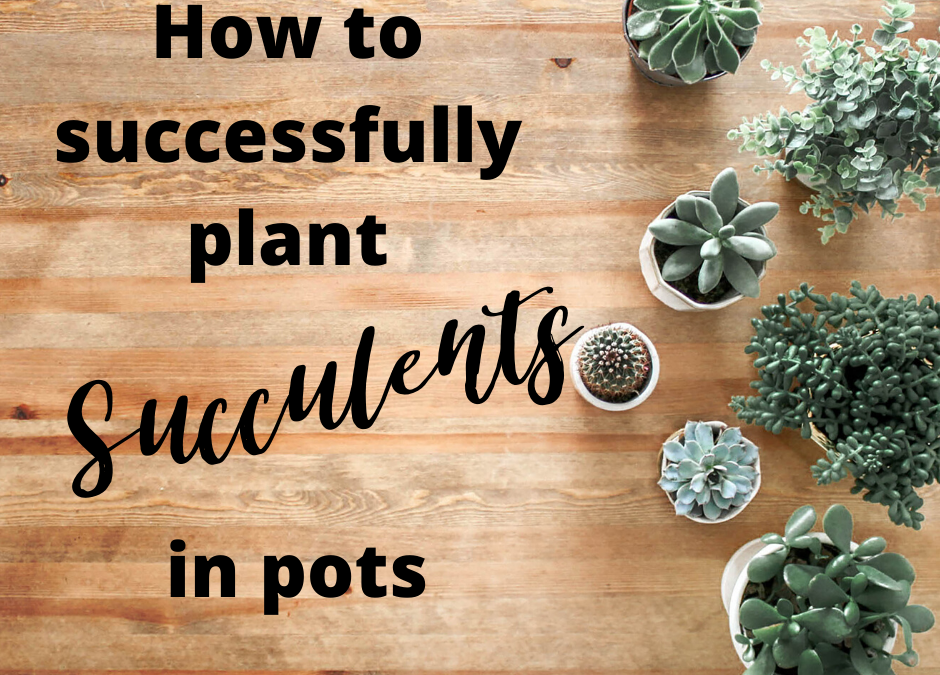Succulents have become one of the most popular house plants in recent years. These plants are fairly simple to care for; however, they shouldn’t be underestimated. Here is a guide to caring for succulents in pots, and keeping them healthy and flourishing indoors.
Potting Succulents Indoors
Best Pot for Succulents
Planting succulents in pots indoors is similar to potting with other plants; the most important thing to keep in mind is having a pot with drainage holes. Choosing a well-drained pot avoids water-logging your succulent, and eventually drowning and killing it.
Terra-cotta pots are perfect to start with! If you find yourself with a pot that lacks drainage holes, plan to lay your plant on its side after watering to allow excess water to drain out. Succulent roots are very fragile, so be gentle when you’re re-potting.
Indoor Potted Succulent Care
Most people assume plants need constant care and watering; however, for succulents, they require a bit of neglect.
Because of their awesome shapes and forms, and tolerance of moderate light, low humidity, and weeks without watering, succulent house plants such as Jade, snake plant, or string of pearls have graced many window sills and accented kitchens wonderfully.
Soil:
Soil is key when potting a succulent. It’s important to have a well-drained potting soil, such as an indoor mix or cactus mix, is a great option. Dirt from your yard or regular potting soil simply won’t do. To make your soil even better, add sand, rocks or gravel; all of these will help with drainage.
Light:
Keep in mind that too much sunlight can scorch your succulent; especially newly planted ones. Gradually introduce your plant to full sun exposure. Ideally, you want to keep you light exposure moderate.
Succulents love light, and need about six hours of exposure to sunlight per day, depending on the type of succulent. A very successful indoor succulent will be in or near an east, south, or west window that gets a few hours of direct sun.
Rotate:
Succulents love their sunlight; however, if yours is sitting in the same spot continuously, it’s likely that it could get scorched, or that’s the only side getting exposure. Rotating your plant is a great way to get all sides of your plant exposed to that necessary sunlight they need.
Plants lean towards the sun, and too much leaning could be a sign they are getting too much sun, so rotating them often will help them stand up straight.
Cleaning and Pest Control:
Just like everything else in your home, your succulent will gradually pick up dust, which can hinder their growth. Using a damp cloth or soft bristled brush, gently clear the plant of any debris.Pests aren’t typically an issue for indoor succulents, but occasionally you may deal with unwanted bugs.
Gnats are attracted to plants when the soil is too wet (probably due to overwatering, or poor drainage). If you’ve noticed that these unwanted bugs have laid eggs or there’s larvae, spray the soil with 70% isopropyl alcohol.
A more common pest is the Mealybug. Overwatering and/or over fertilizing are usually the cause of mealybugs infestation. Moving your infected plant away from your other plants, and spray the soil with 70% isopropyl alcohol.
Watering and Feeding:
As stated above, succulents can deal with a bit of neglect, so watering doesn’t have to be a weekly endeavor. You will; however, want to pay more attention to it’s water schedule per season.
Just like us, succulents need more energy when they’re in a period of growth. During the spring and summer, the plants are thriving and drinking up much more water than when they’re resting in the fall and winter.
A common recommendation is testing the soil with a finger—when the top 1.25 inches are dry, it’s time to water your succulent. Water your succulents enough so that they don’t shrivel, but keep in mind that overwatering can kill your succulent, so make sure you let the soil dry between watering.
Water your soil directly, and when doing so, soak the soil until you see water running out of the drainage holes. This amount of water will hold the plant over until the next time you need to water it. If your pot doesn’t have drainage holes, use less water.
Because succulents can seem sensitive, some believe using a spray bottle is a safe bet for watering their plants. This could do more harm than good. Misting your succulents can cause brittle roots and moldy leaves.
It is best to use a watering can, or water pitcher. Another form of watering your succulents, is to place your potted plant in a pan of water, and allowing the water to absorb through the drainage holes. Once the top of the soil is damp, the plant is fully watered!
As far as fertilizer goes, succulents don’t need much; but in the spring and summer when they are growing a bit more, you can give them light feedings. Over fertilizing can cause your succulent to grow too quickly and become weak.


Recent Comments
Original EZGT001 Gate Latch Pull In Black
Original EZGT001 Gate Latch Pull In Black
Original EZGT001 Gate Latch Pull In Black
Original EZGT001 Gate Latch Pull In Black
Original EZGT001 Gate Latch Pull In Black